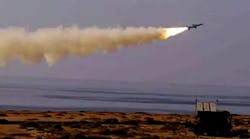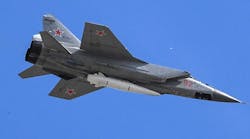About three weeks after invading Ukraine on Feb 24, Russian forces fired a hypersonic Kinzahl air-to-surface missile from a MiG-31K Foxhound fighter jet into an underground weapons depot in Ukraine. The missile has an estimated range of 1,250 miles and can fly at 7,670 mph, which is 10 times the speed of sound or about 2 miles per second.
The missile can carry a conventional or nuclear warhead. And the kinetic energy of the 1,100-lb Kinzahl missile travelling at Mach 10 is enough to sink an aircraft carrier even if it’s not outfitted with an explosive warhead.
Russia and China have hypersonic missiles in their arsenals, but this is the first time one has been used in combat. Other countries, including the U.S., Australia, France, Germany, India and North Korea, are developing versions of their own.
“The U.S. has been developing, building and testing hypersonic systems for decades,” says Kelly Stephani, a mechanical science and engineering professor at the University of Illinois Urbana-Champaign. “NASA’s X-43 experimental unmanned aircraft flew at Mach 7 and Mach 10 in the early 2000s, and the Boeing X-51 Waverider demonstrated hypersonic flight again in 2010. From there, honestly, we took our foot off the gas. Other countries realized the strategic significance of the technology and have taken the lead. It is imperative that we not only catch up, but leap ahead in capability.”
One advantage hypersonic missiles have is that when they fly that fast within the atmosphere, the air pressure an heat in front of it forms a plasma. It absorbs radio waves and adds a layer of stealth that makes it practically invisible to active radar systems.
“These missiles travel at immense speeds that significantly shorten or eliminate response times for defensive weapons,” says Stephani. “They can also maneuver and follow trajectories different from a standard intercontinental ballistic missile or ICBM. For example, they can fly below the line-of-flight detection capability of ground-based radars, making them more challenging or impossible to intercept from the ground-based defense systems. They are also dimmer and more difficult to detect from above, making the prediction of their final intended target more difficult.”
She points out that traditional intercontinental ballistic missiles travel at hypersonic speeds, but they follow predictable, parabolic trajectories, making them easier to intercept. Boost-glide and cruise missiles travelling at hypersonic speeds have the advantage of maneuverability in midcourse, glide, and terminal phases, and a low-altitude trajectory that makes them challenging to see and practically impossible to intercept.

